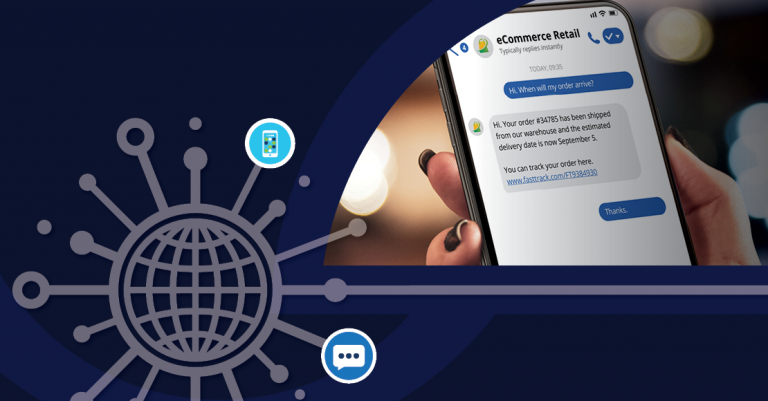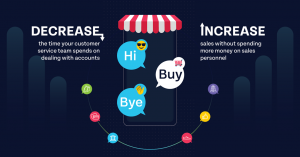What is Conversational Commerce?
What is Conversational Commerce? Conversational commerce is transforming the way businesses all around the world engage with their customers anywhere and everywhere. Especially during the post-pandemic world that we now live in, this new way of shopping adds the value of human connection and social interaction back into the way we interact with one another online. This technology allows merchants to give their clients the same high-quality customer experience as if they had come into the physical store. Conversational commerce provides an interactive environment where consumers can find information, shop, purchase products, communicate with, and transact with the companies they love with the power of convenience and personalization. It’s an extremely effective omnichannel marketing strategy that has been a proven success with both customers and merchants all over the world. Conversational Commerce 101 So, what exactly is conversational commerce and why is it becoming so popular? Conversational commerce includes any tool that helps companies develop and enhance their customer experience and user journey while building brand loyalty. This new technology is more than just plain old customer service or buying products; it is turning a one-way dialogue into a conversation, a personalized interaction between buyer and seller. It creates a quick and easy way for consumers to find the product or details they need when they need it, and guide them seamlessly into making a purchase through AI, such as chatbots and or messaging apps. Conversational commerce is fundamentally changing and revolutionizing the way your customers expect to interact with your business. And the best part? It creates substantial efficiencies, workflows, and processes within your business—as well as for your customers. It is sure to boost customer satisfaction and response times, alleviate stress from your sales teams, as well as help your brand adapt toward the trends and world we live in today. Different Types of Conversational Commerce The number of tools that conversational commerce professionals use is constantly growing since consumers will always have a need to communicate with businesses. A recent consumer survey found that 63% of U.S. consumers prefer messaging more than other forms of communication and would switch companies to access it. Even people who like to speak with a customer representative have the expectation of facing delays, hold times, and the possibility of a dropped call. We conducted our own research to better understand consumer behavior around conversational commerce and chat. We found that: 88% of consumers regularly use chat apps like Facebook Messenger and Apple iMessage on their mobile devices. 54% of consumers say that they have already chatted with companies using a chat app. Millennials lead the trend in chatting with companies. About 33% of consumers have purchased items through chat, and 77% say they're open to the idea. There’s a huge chance that you have seen conversational commerce in action yourself! Here are a few common examples of conversational commerce that could be used to guide meaningful conversations with customers through chats to ultimately provide them with a superior and preferred shopping experience. SMS Communications SMS (Short Messaging Service) text message is a simple, cost-effective way for customers to send an instant message and get information from your business without the wait. When given the options to SMS, many people will use this channel to ask important questions that help increase engagement with your business. Some popular questions businesses use SMS communications for include: Information on expected delivery time Order confirmation Schedule an appointment Make a reservation Invoice or bill payments Update personal information Business contact information Create new accounts/passwords Businesses can also use SMS to let customers know about topics like new products, special promotions, critical information about their business, and discount opportunities. As long as customers opt-in for the texts—and you give them an easy way to opt-out—you don’t risk spamming them with annoying messages. At Clickatell, we help you seamlessly integrate your current applications with our SMS service so that you can send a bigger volume of messages while using an intuitive, no-code interface that does not require deep technical expertise. Let our team work harder so that you and your sales team can work smarter. Automated Chatbots The development and continual improvements of automated chatbots are helping drive the growth of conversational commerce. Chatbots do an amazing job at answering basic questions, particularly the repeat inquiries that make up a substantial portion of interactions with your customer service team. With the right approach, you can make a conversation with your automated chatbot feel like a natural extension of your brand. The key is to make sure you frame both questions and answers in your brands’ tone and voice. The bot on your website can ask visitors, “How can I help you today?” and provide a list of responses, such as: Pay a bill Schedule a call Leave a message Change an appointment time Get an estimate Open an account The list of questions is limitless, as long as the answers are simple and repeatable responses to the questions that are being asked. When a customer chooses a response, the chatbot sends them to the appropriate option. Done right, it feels very natural, very much like communicating with a live human via chat. What if you still want to offer live agent assistance to your clients? Of course. You can create automated chatbots that know when to pass customers over to your customer services department. If the bot cannot fulfill the request, it sends the visitor to a human representative who can have a more complex conversation and make decisions in real-time. You truly get the best of both worlds when using this method! Clickatell’s Chat Desk is an advanced digital contact center solution that relies on conversational technology to help provide customer support through a mix of conversational commerce and live agent interactions. Chat Desk works by giving your customers the ability to get immediate answers from a live agent through whatever channel they choose—online web Chat or mobile Chat apps like WhatsApp – reducing contact center costs, helping customers get information and resolve issues quickly, and giving the contact center greater flexibility to manage teams, while increasing their call volume and customer satisfaction. Chat Apps Communications using chat apps give you a chance to form relationships with consumers via platforms they already use—and love—for exchanging messages with friends and family members. WhatsApp is a great example. WhatsApp is extremely popular globally, exceeding 2 billion users in 2020. Roughly a quarter of the world’s population uses WhatsApp. We can help you take advantage of WhatsApp’s most useful features to: Protect customer data with end-to-end encryption. Send notifications about upcoming deliveries, payment alerts, and other time-sensitive tasks. Automate responses to messages that customers send you. While WhatsApp is the most popular messaging app globally, Facebook Messenger, Apple iMessages, Google Business Messages, Instagram, WeChat, and other emerging Chat apps are all incredibly powerful conversational technologies. Each app may appeal to a different demographic or age group so the key for any business is to find which app your customers prefer and to develop a strategy to include those channels as part of your mix. Voice Assistants Voice assistants are some of the newest conversational technologies you leverage to improve services and increase sales. Here, too, there are numerous options, with one that’s clearly outpacing the rest when it comes to current adoption. Nearly 70 percent of people who own smart speakers choose the Amazon Echo, which comes with an Alexa voice assistant. Alexa can do much more than play your favorite workout album or tell you tomorrow’s weather forecast. It can also take purchase orders from owners. Since Amazon owns Alexa, most Alexa purchases come from Amazon-owned businesses, including Whole Foods. Alexa is something of a gatekeeper in this way, but it still shows the promise of using voice assistants to develop conversations between customers and brands. Google Assistant gives you more opportunities to reach customers without a gatekeeper standing in the way. Google Assistant has about half a billion users. Optimizing your online content makes it easier for Google Assistant to find, recommend, and tell people about your business. Currently, you can’t make personalized scripts for your brand, but we many believe that development is just around the corner. 3 Simple Steps to Get a New and Improved Customer Experience As a global messaging and Chat Commerce leader, Clickatell helps you maximize your outreach and track performance with our years of digital chat experience and track record of success. If you haven’t already started using conversational commerce, start today by implementing Clickatell’s SMS Solution to begin easily scaling your marketing strategy with messaging. Integrating your business with an SMS solution is the first step to leaning toward this new reality of chat commerce by using the power of convenience! To take your digital marketing strategy one step further, integrate Clickatell’s Chat Desk to further engage with your customers in the way they prefer. Streamline your company's transactional messaging with our Chat Desk solution and let’s improve your brand’s customer journey together. The real winner for your business is conversion — focusing on guiding your customers to actually buy your products through their preferred chat channels. Meet your customers where they already are, by using Clickatell’s Chat Commerce to allow your customers to enjoy convenient digital customer support, account management, and transaction services all from within chat! Learn more by reaching out to Clickatell! The possibilities with chat are endless. Let our team help your business start elevating your customer experience and boost revenue by optimizing conversational technologies today.








